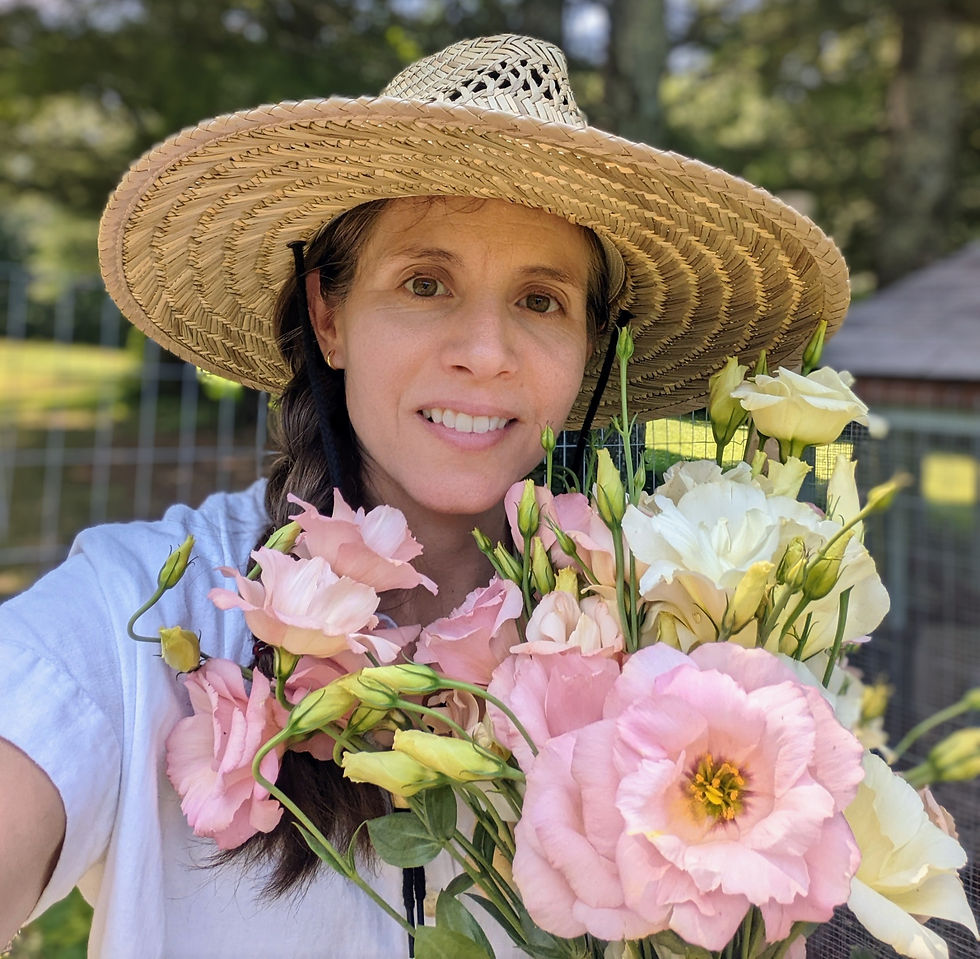Summer Flowers: Lisianthus
- Laura Morris
- Aug 14, 2023
- 3 min read
Updated: Aug 15, 2023
A beautiful flower for the heat of summer, lisianthus comes to the rescue when you need filler or focal flowers. It has a great vase life and can be a beautiful addition to your garden or farm.

Our Story
The first thing you need to know about lisis are that they are notoriously hard to start from seed. One of my first years flower farming, I decided to order the seed packets bearing the pictures of beautiful lisianthus. There were so many choices that hopped off the screen as I made my selection. The seeds of lisianthus are so small that these particular seeds came pelleted, coated in an organic clay, in a small plastic vial. I followed the planting instructions and got about one fourth of the seeds to germinate and produce a viable plant as I started the seeds indoors. That amount dwindled as I continued to care for them and forgot to water on time or put them out to harden off in too much sun, etc. By the time I got around to planting, I had nothing to show for the seeds I had purchased. That year, the lisis were a bust. Determined to figure something out so that I could try out the plants, I ordered plugs the next year, splitting trays with another grower friend. Plugs are seedlings that you can purchase by the tray from specific growers. I planted out the plugs, looking, specifically, for varieties that can be planted without netting. The plants survived and produced beautiful blooms.

Care & Maintenance
If you want to try to grow lisianthus from seed, make sure to do your research first. Because lisianthus are hard to start from seed there are lots of great resources out there to help you on your journey. Check out this video from Blossom & Branch Farm. Reasons to start from seed are 1) it is cheaper, 2) you can grow the number you need, and 3) you can get the flowers you want versus what you can find.
If you decide to go with plugs, check out Farmer Bailey's post on lisianthus. Make sure to get plants in the ground as soon as possible after receiving your plugs. Plugs should be planted when the soil is still cool, around 55 degrees. Lisianthus are tolerant of cooler weather and should be planted out 2-4 weeks before the last frost. Plugs can be planted close together because of the shape of the plant. Plants need more water as they get established. Once they have begun to grow, they become more drought tolerant.
Try to stay on top of the weeds! These little plants can easily get overrun with weeds if you do not use plastic mulch. My lisianthus beds are in need of a good weeding.
Finally, lisianthus are grouped into four different groups, depending on when they bloom. You can extend your growing season by trying to grow plants from each group. If you have never grown lisianthus before, pick out varieties from each group and test them out to see what works for you.

Harvesting
Harvest in the morning or the cool of the evening. Harvest lisianthus when the first flower has begun to open. Snip the stem almost to the ground. Harvest into a clean bucket with clean snips. If the first flower has begun to fade, snip that flower off to encourage the other flowers to bloom. Store lisianthus blooms above 40 degrees once harvested. They do not like the cooler. As they have a long vase life, I am able to store lisianthus well in the shade of my flower area rather than putting them in the cooler that is kept below that temperature. I harvest them into a hydrating solution and then move them into a holding solution to help them last as long as possible.

Other things to consider
Keep an eye out for any lisianthus that suddenly turn brown and die back. This is most likely due to fusarium. Pull the plant and make sure to burn or it throw out. Do not add it to your compost pile.
Are you interested in growing lisianthus or does it seem like too much trouble? From my experience, once you decide to grow it, you will not regret that decision.
This post is part of a year-long series on flowers and plants that we love and grow on the farm. Check out other flowers that we love.
Strawflower | Gomphrena | Celosia | Zinnias | Cosmos | Sunflowers | Yarrow | Roses





Comments